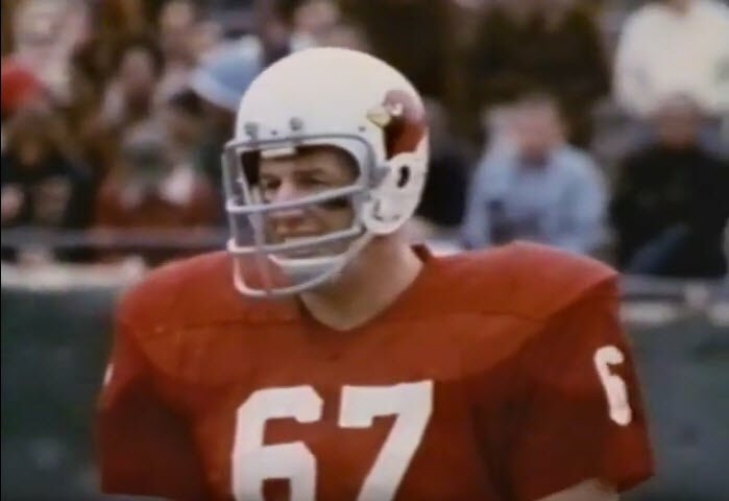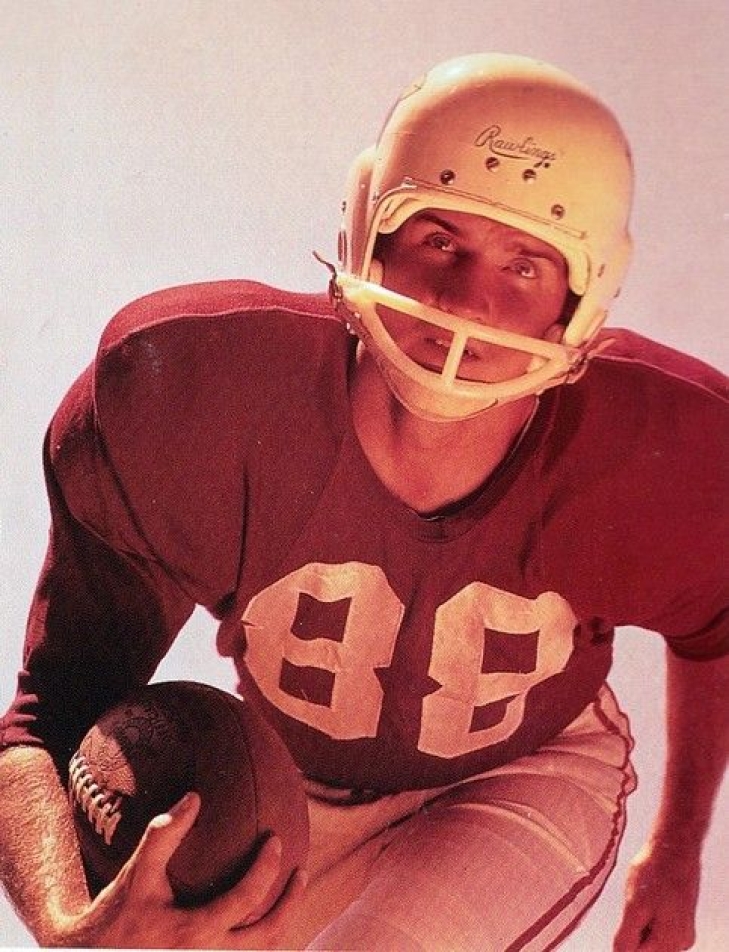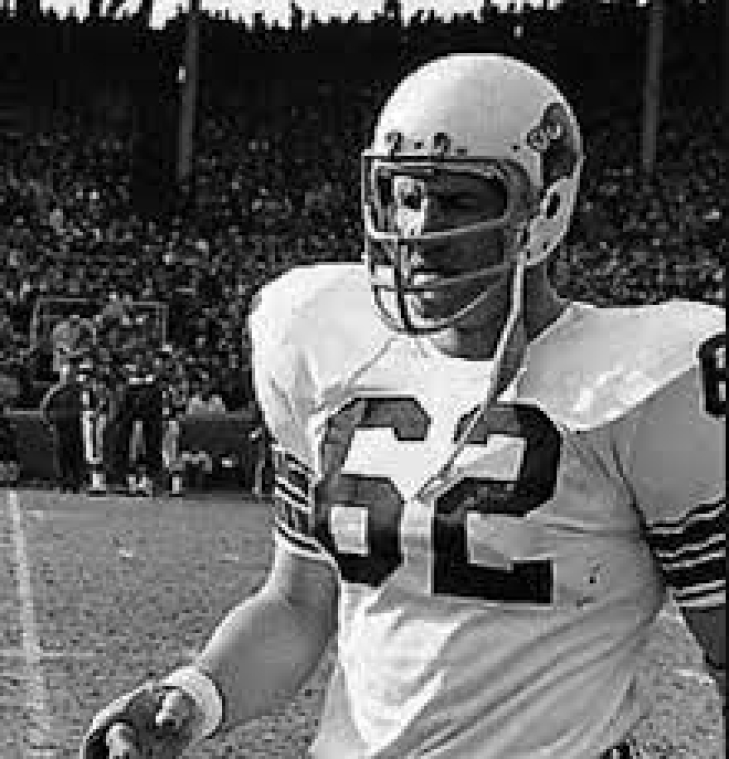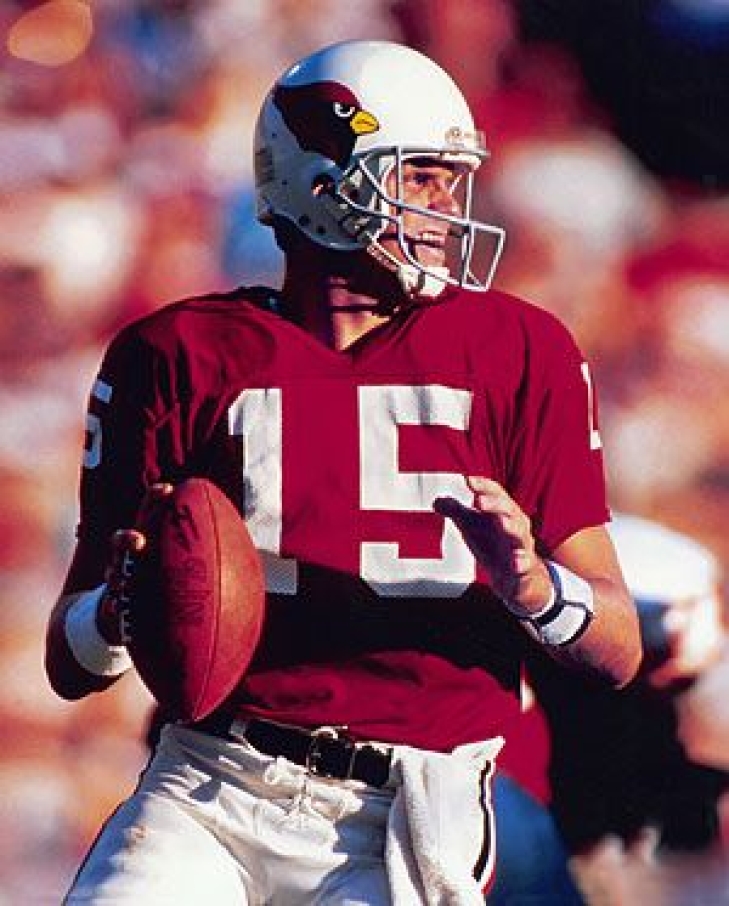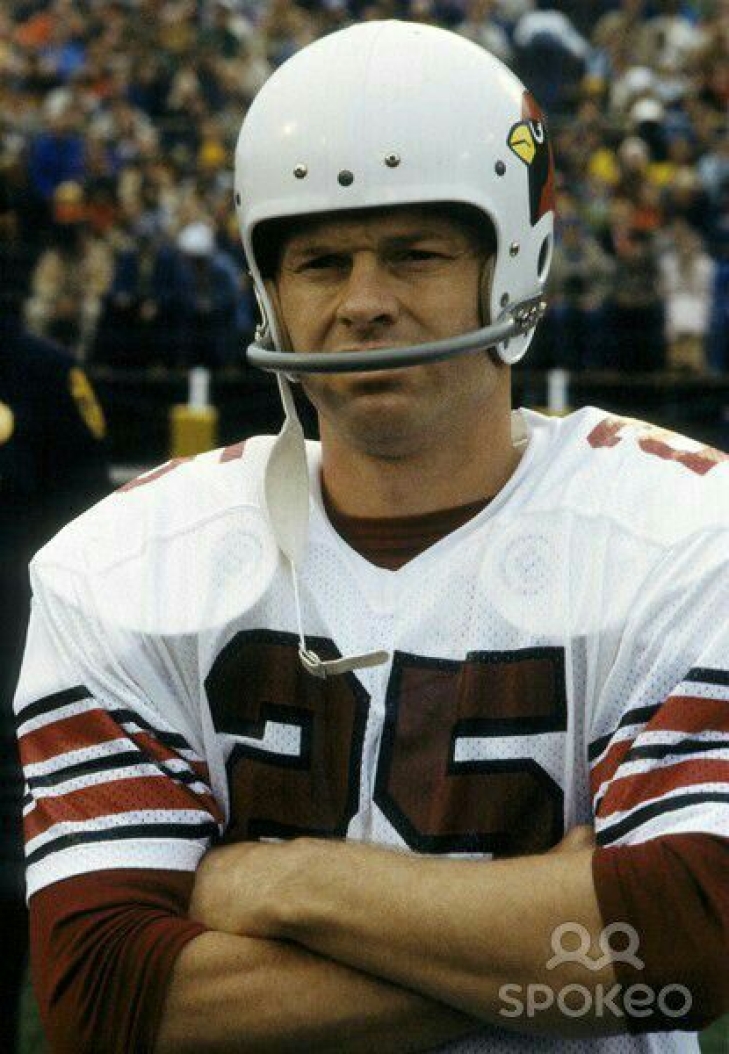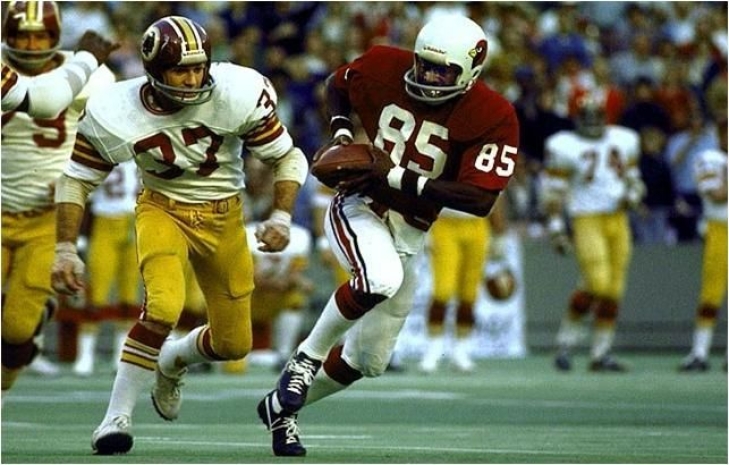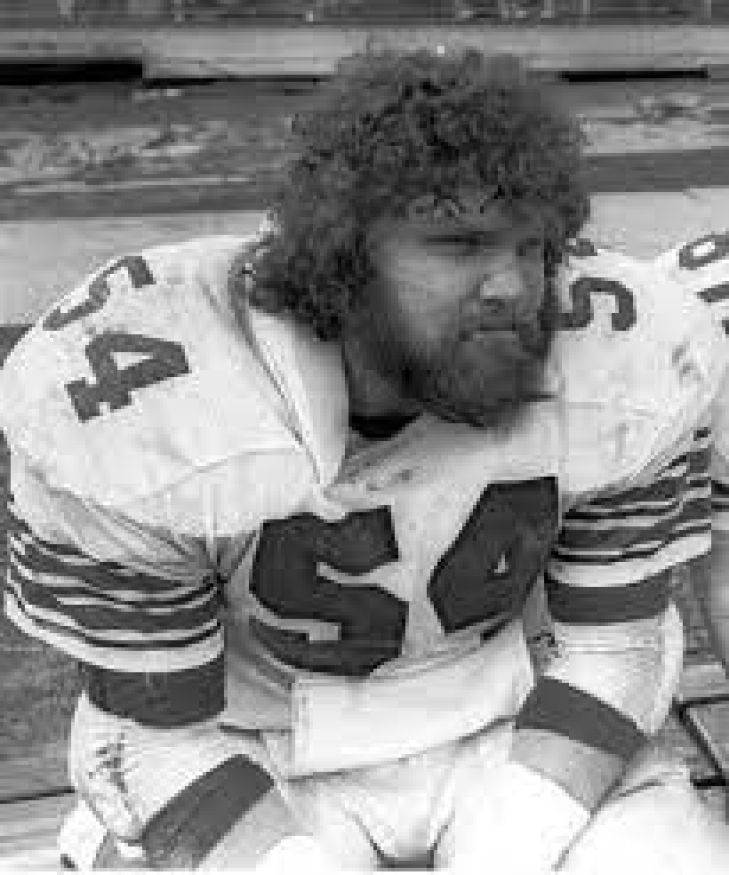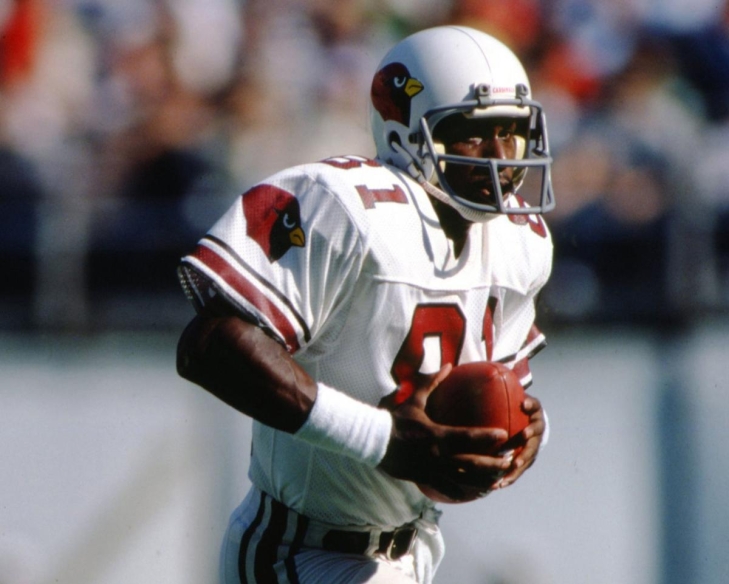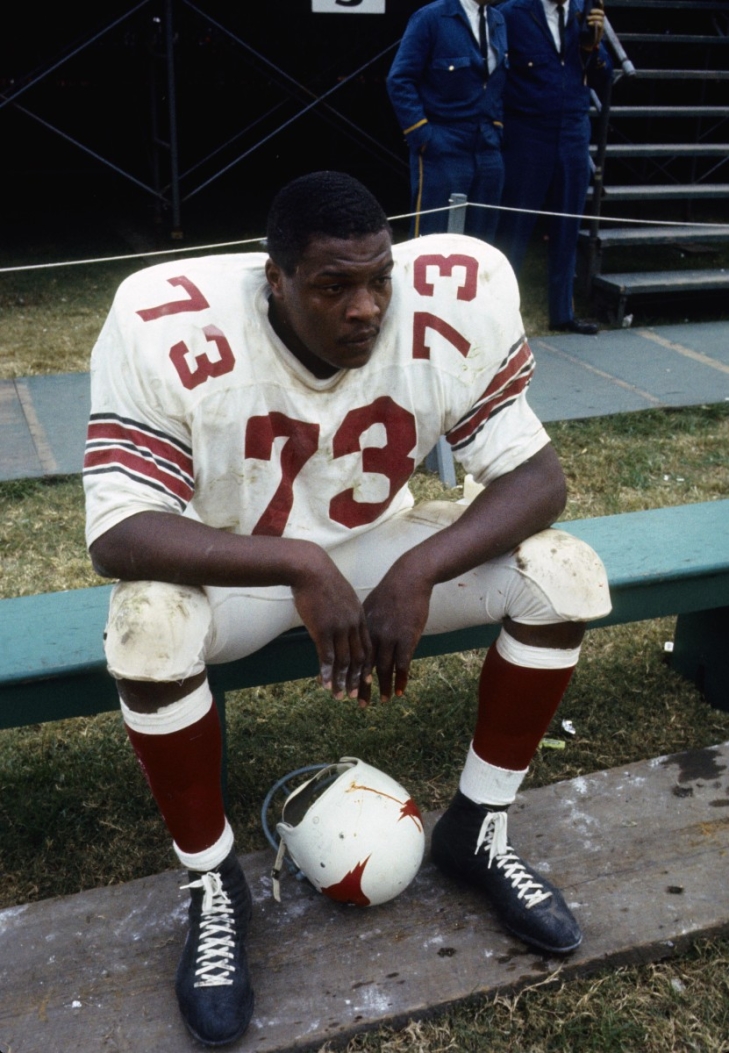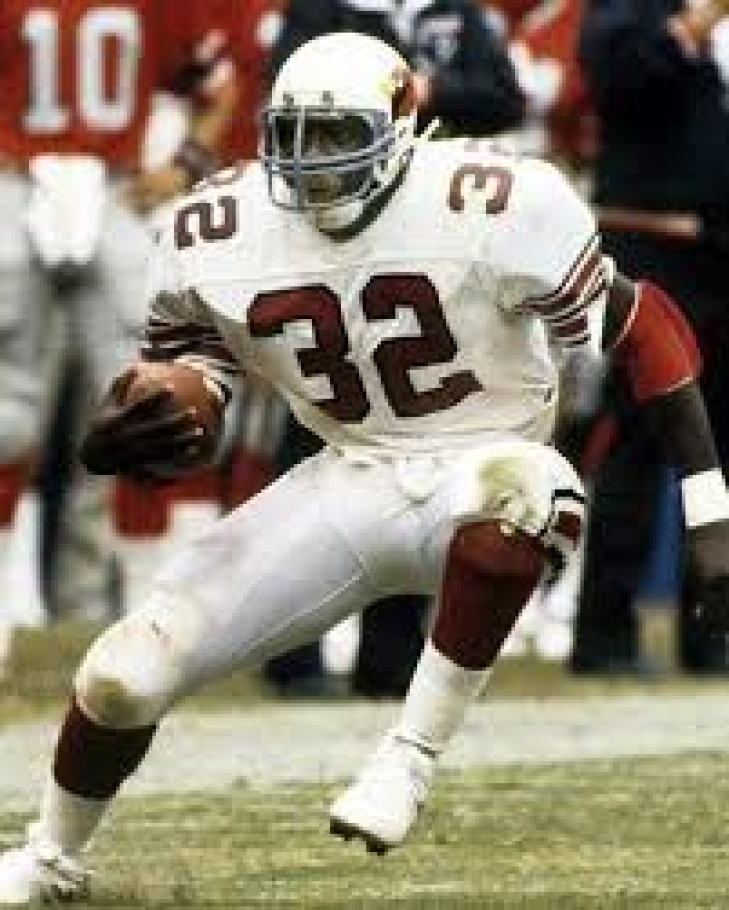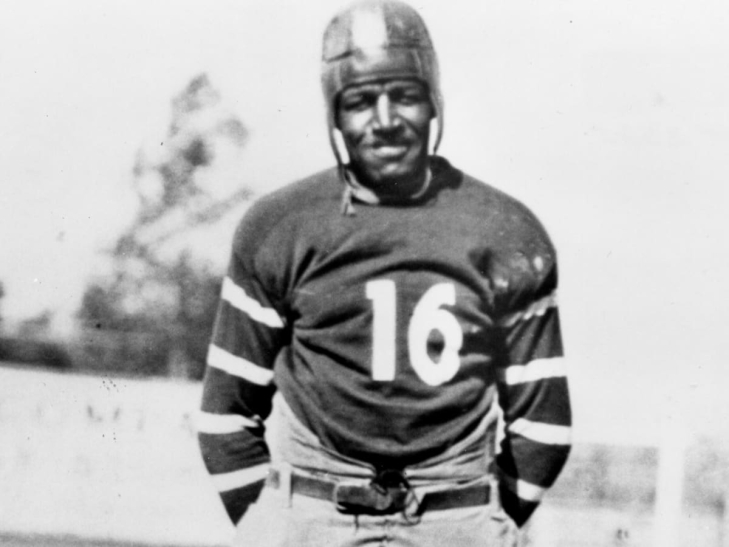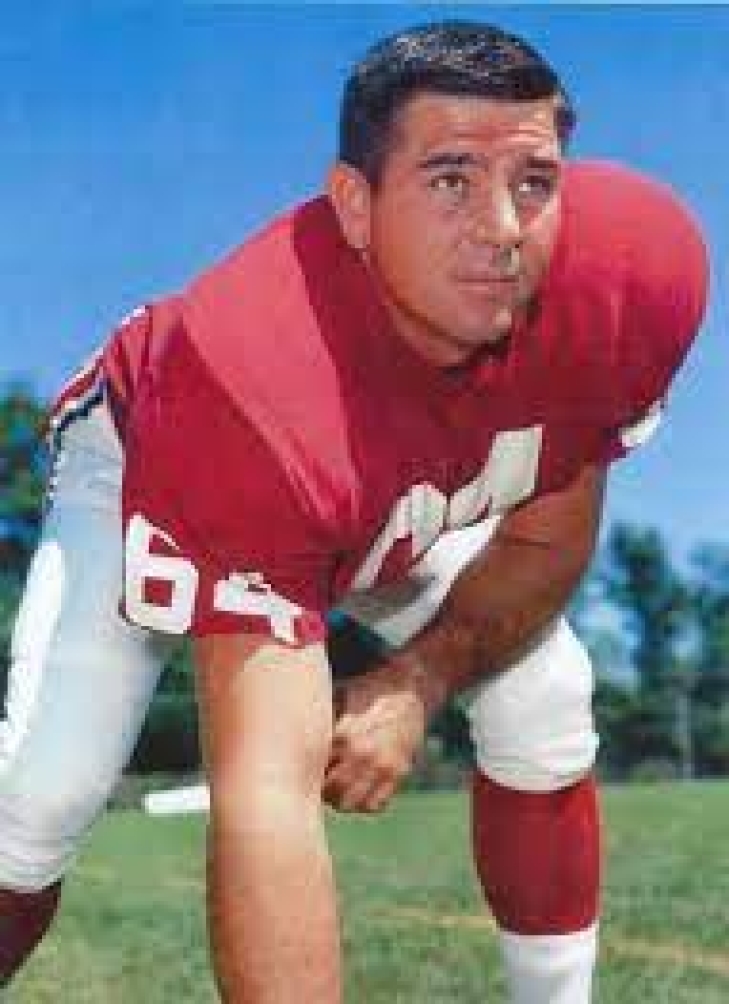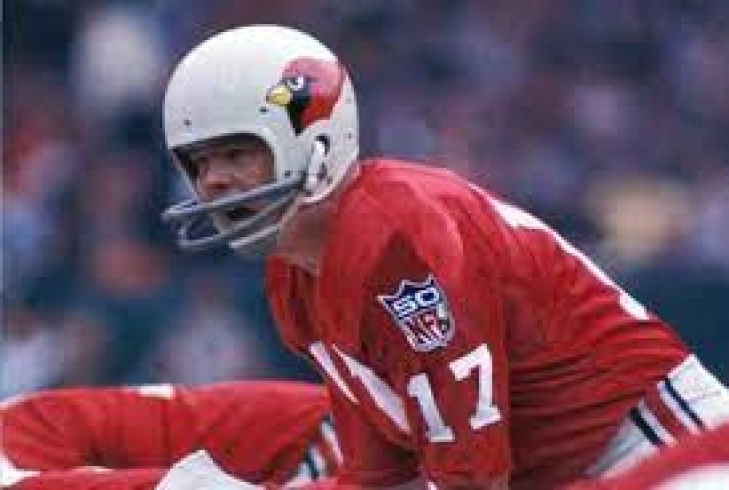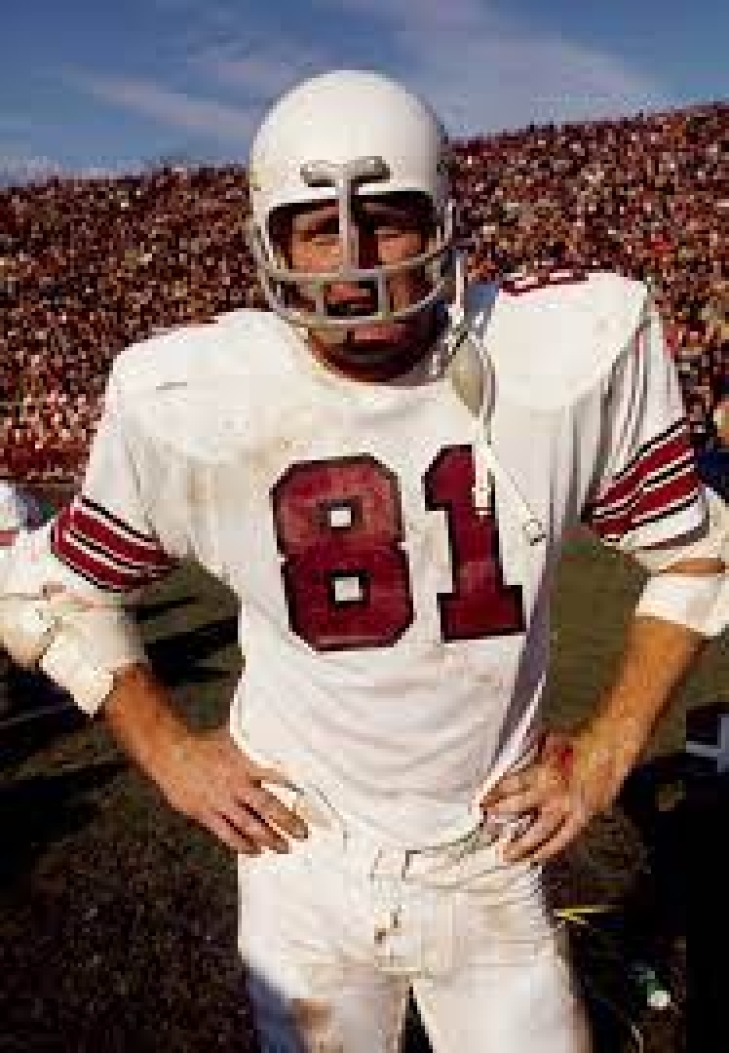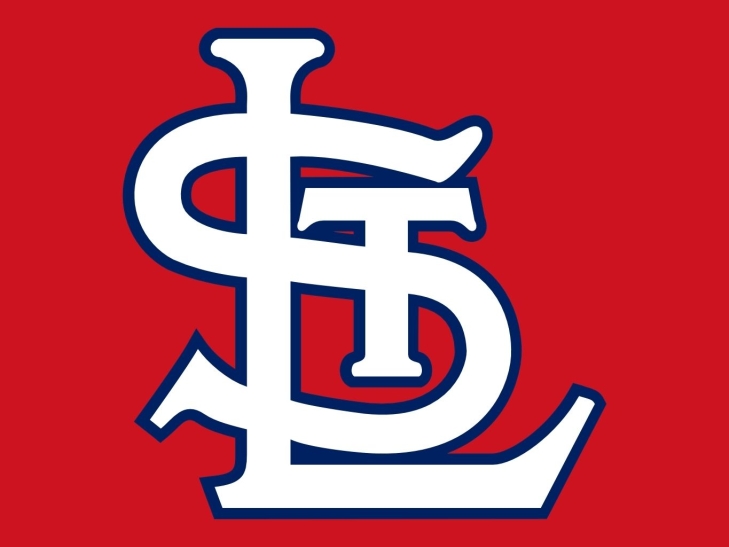33. Larry Stallings
For 14 Seasons, you knew exactly who would be at Left Linebacker for the St. Louis Cardinals, and that man was Larry Stallings.
An 18th Rounder from Georgia Tech, Stallings proved to be a steal for the Cardinals, as save for his second and third year, he was healthy and dependable and recorded a lot of tackles for St. Louis. A Pro Bowl Selection in 1970, Stallings contended for other appearances to the annual all-star affair.
He retired after the 1976 Season, having played 181 Games for the Cards.
32. Sonny Randle
Sonny Randle was a “futures” Draft Pick, meaning that the Chicago Cardinals used their 19th Round Pick in 1958 to select Wide Receiver Sonny Randle, who was still slated to play one more season with Virginia. Randle would make the Cardinals as a rookie, but when the team relocated the next year to St. Louis, he was made a starter and would have the best season of his life.
In 1960, Randle led the NFL in Touchdowns (15) with 893 Receiving Yards. The former Cavalier earned his only First Team All-Pro and began a three-year run of Pro Bowls, punctuated with a career-high 1,158 Yards. Randle did not win a post-season accolade in 1963, though he was solid with 12 TDs and 1,014 Yards. He would gain a fourth Pro Bowl in 1965 (845 Yards and 9 TDs).
Randle left for San Francisco, and compiled 60 Touchdowns and 5,438 Yards with the Cardinals.
31. Dale Meinert
Dale Meinert was initially drafted into the NFL by the Baltimore Colts, but he never played there, instead playing for the Edmonton Eskimos of the Canadian Football League, where he won two Grey Cups. He would return to the United States in 1958, joining the Chicago Cardinals becoming a starting Guard. As the Cardinals relocated to St. Louis in 1960, he was relocated on the gridiron, switching to Middle Linebacker.
Meinert fit better on the defensive side, winning three Pro Bowls and the team MVP in 1961. As the Cardinals were not a league power in the 1960s, Meinert’s contributions are not as celebrated as they should be, but this man was the team's best interior lineman for years.
35. Neil Lomax
A superstar at Portland State, Neil Lomax allegedly set 90 records while he was the Vikings Quarterback. This afforded him a rarity for a Portland State player, a high draft pick (2nd Round in 1981) in the NFL Draft.
Lomax saw action in his inaugural year, learning from the aging Jim Hart, and was an All-Rookie. Playing in the then hyper-competitive NFC East, the Cardinals Quarterback only had two winning seasons and one Playoff Game, but when he was on, he was as good as anyone in the NFL. Twice named to the Pro Bowl, Lomax led the NFL in Pass Completions (275) and Passing Yards (3,387) in 1987 and had 22,771 Yards with 136 Touchdown Passes overall.
An arthritic hip forced Lomax to sit out all of the 1989 Season, and before the next campaign, he retired due to its severity.
27. Jim Bakken
Drafted by the Los Angeles Rams in 1962, Jim Bakken did not make the Rams roster out of training camp but was scooped up by the St. Louis Cardinals, a team he would play 15 years for.
Special Teams advanced considerably during Bakken's time, and he was one of an emerging group of specialty Kickers. Chosen for four Pro Bowls and two First Team All-Pros, Bakken is one of the few players to be selected for two All-Decade Teams (60s and 70s), and at one time was the single-game record holder for Field Goals in a Game (7).
His 1,380 Points is by far the most in franchise history.
26. Bob DeMarco
Bob DeMarco centered the Cardinals throughout the 1960s, debuting in 1961 and becoming a starter the year after. DeMarco was solid throughout the decade, netting three Pro Bowls (1963, 1965 & 1967), with the last of the three also seeing him with a First Team All-Pro.
DeMarco left St. Louis after the 1969 season, playing five more years in the NFL. DeMarco started all but five of his 107 Games with the Cardinals, and the franchise never had to worry about Center for eight strong years.
25. Mel Gray
The St. Louis Cardinals did not have to look far to find their next star, Wide Receiver, as Mel Gray played his college ball at the University of Missouri, where his speed is still legendary.
Gray was a Sixth Round Pick in 1971 and broke out in the 1974 campaign, where he began a streak of four consecutive Pro Bowls. While he never had a 1,000-Yard-Receiving nor a 50-Reception year, Gray was the man that the Cardinals viewed for big-money plays, which were much harder to come by in the 1970s than today. Gray was in the top ten in Yards per Reception in seven different years, peaking at second in 1977 with 20.6. He led the league in Touchdown Receptions in 1975 with 11, which coincided with his solitary First Team All-Pro.
After his peak, Gray played for St. Louis until 1982, compiling 45 Touchdowns and 6,664 Receiving Yards.
24. Tom Banks
Tom Banks would become a steal for the St. Louis Cardinals when they got the Auburn Offensive Lineman in the 8th Round of the 1970 Draft, but it would take years to realize that value.
Banks missed the entire 1970 Season because of a knee injury but came back to take over the starting duties at Center. He played more at Left Guard in 1973, but another knee injury took him out of all but the opening game of 1974, right after he returned to Center. Banks remained the starter upon his return and promptly went on a four-year run of Pro Bowls, where he was arguably among the best directly in front of the Quarterback in the NFC. He would also secure a First Team All-Pro in the bi-centennial year of 1976.
Banks played until 1980, retiring with 110 Starts in 116 Games.
22. Luis Sharpe
A Cardinal for the entirety of his 13-year NFL career, Luis Sharpe was the second Offensive Lineman taken in the 1982 NFL Draft, behind only Hall of Famer Mike Munchak. It is a safe assumption that the Cards got the second-best Offensive Lineman of that draft.
Playing for the team while they had geographic designations of St. Louis, Phoenix, and Arizona, Sharpe started all 189 of his Games at Left Tackle, achieving Pro Bowls in three straight years (1987-89) while obtaining Second Team All-Pros in 1988 and 1990. He rarely missed games, stayed relatively healthy for most of his career, and was the building block for over a decade that the Cardinals attempted to build around. The team was not that successful in that regard, as he only appeared in one playoff game, but Sharpe was their top lineman for many years and deserved this spot.
21. Roy Green
In the same draft that the St. Louis Cardinals grabbed an elite Running Back (Ottis Anderson), they landed a top-flight Wide Receiver in Roy Green, though it took longer before that selection paid dividends.
Green was used more as a Returner in his first two seasons before seeing significant action as a Wide Receiver. A permanent starter by 1982, Green broke out in 1983 as a First Team All-Pro and Pro Bowler, leading the NFL in Touchdown Receptions (14) with his first 1,000 Yard year (1,227). Green again was a First Team All-Pro and Pro Bowl Selection in 1984, this time with 12 TDs and 1,555 Yards, with the latter statistic topping the leaderboard.
Green was unable to repeat this success as injuries began to compile, but he did have another four-digit Yard year when the franchise relocated to Phoenix in 1998. He played with the Cardinals for two more seasons before he played two final years in Philadelphia. As a Cardinal, he accumulated 8,496 Yards and 66 Touchdowns and entered the team's Ring of Honor in 2016.
18. Ernie McMillan
Save for his final season as a Green Bay Packer, Ernie McMillan enjoyed a long career as a starting Offensive Tackle for the St. Louis Cardinals, a team he played 14 straight years (1961-74).
McMillan started three Games as a rookie in 1961, and over the next 12 years, he was St. Louis's starter at Right Tackle over the next twelve years. The former Fighting Illini went to four Pro Bowls (1965, 1697, 1969 & 1970) and was twice a Second Team All-Pro.
16. Ottis Anderson
Ottis Anderson made University of Miami history as the first Running Back to go for over 1,000 Yards. The NFL took notice, and St. Louis, who had the Ninth Overall Pick, grabbed the dual-threat Running Back.
Anderson had one of the best rookie seasons among rushers, what turned out to be his career-high in Rushing Yards (1,605) and Yards From Scrimmage (1,913), and was named the Offensive Rookie of the Year. He was also named a First Team All-Pro, a Pro Bowler, and UPI and The Sporting News elected him as their MVP.
Anderson's second year was also Pro Bowl worthy (Rushing Yards), but it would be his last Pro Bowl Selection, though he was still a potent rusher. Anderson rushed for over 1,000 Yards over three of the following four Seasons and probably would have done so in 1982 had there not been a strike.
The Cardinals traded Anderson in what was a surprise move to their then-division rival, New York. Although Anderson’s Giants numbers paled to his work in St. Louis, he was still solid and would win a Super Bowl MVP for his second and final club.
Anderson compiled over 10,494 Yards From Scrimmage with the Cardinals and 53 Touchdowns.
15. Duke Slater
The story of Duke Slater is unique, as very few men can say that they have blazed paths as much as he did.
Slater played his college ball at the University of Iowa, helping them win a share of the National Championship. He signed with the Rock Island Independents following his college career, making him the first African-American Linemen in league history. In 1926, Slater signed with the Chicago Cardinals, making him the first black signee of any team still in existence regarding current NFL teams.
Slater played five years and part of another year for the Cards and was one of their best performers throughout. In every full year, he was with the team, he received a version of an All-Pro and had a seven-year stretch doing so, making him the first Lineman to accomplish that feat. The legendary George Halas described Slater as a one-man line, and praise does not get much better than that.
Following his retirement, there was an unofficial ban on African Americans that stood for nearly 20 years. He continued to break barriers in his personal life, becoming an attorney in 1933 and later a judge. Slater would posthumously enter the Pro Football Hall of Fame in 2020.
14. Ken Gray
Ken Gray was drafted by the Green Bay Packers in 1958 but was unable to make their roster. The Chicago Cardinals took a shot on him, using him at Defensive End as a rookie, but the season after, he was moved to Right Guard, a position he would thrive in.
The Cardinals relocated to St. Louis in 1960, and while Gray was not a star in Chicago, he would become one under the Arches. Gray went to his first Pro Bowl in 1961 and added five more (1963, 1964, 1968, 1967 & 1968) with three All-Pros along the way. Arguably the Cardinals' best Offensive Linemen in the 1960s, he began the next decade with Houston, where he played one year before retiring.
12. Jim Hart
As the passing game opened up, many Quarterbacks received their due as national stars. Jim Hart was one of the new breed of pivots, though he did not generate the same buzz as some of his peers.
It wasn't that the Cardinals didn't have any good seasons while Hart played there, as in the mid-70s, they rifled off three consecutive ten-win seasons. This period coincided with Hart's four straight Pro Bowl appearances. Jim Hart became one of the most durable and respected Quarterbacks in the NFL, and due to that durability, he was able to accumulate a very impressive career in terms of statistics.
Unfortunately, as the leader of bad teams for the majority of his career, Hart was considered a good player, who wasn’t good enough to take his team to the next level. This may explain why he never received any real look from football historians, though it should be acknowledged that UPI named Hart their MVP in 1974.
With the Cardinals, Hart amassed 34,639 Yards and an even 200 Touchdown Passes, and he was selected to join the Cardinals Ring of Honor in 2017.
8. Jackie Smith
The speed of Jackie Smith earned him a late-round selection (10th Round) in 1963 by St. Louis, who converted the Flanker into Tight End.
Smith was an excellent blocker, but his receiving skills helped transform the position, and he amassed 7,918 Yards with 40 Touchdowns from the air. He also earned five consecutive Pro Bowl Selections (1966-70).
Notably, Smith also served as the Cardinals Punter for his first three years.
He entered the Pro Football Hall of Fame in 1994.
5. Dan Dierdorf
Considered to be the best Offensive Lineman in Cardinals history, Dan Dierdorf was the game’s premier Tackle in the 1970s.
A Cardinal throughout his 13 NFL seasons, Dierdorf settled into the Right Tackle slot in his fourth year. The move was perfect for Dierdorf, who would earn Pro Bowl accolades that year and the next four, with a sixth one in 1980. Dierdorf was named an All-Pro (three First and three Second Team) in all those Pro Bowl seasons. He was so good at his peak that in 1976 and 1977, he did not allow a single sack.
Dierdorf, who was born in Canton, would fittingly enter the Pro Football Hall of Fame in 1996.
The Cardinals also honored Dierdorf in 2006 as a member of the inaugural group in their Ring of Honor.
4. Roger Wehrli
As Larry Wilson’s career was winding down, the St. Louis Cardinals had another star Defensive Back in Roger Werhli to take over command of the secondary.
An All-American at Missouri, Wehrli impressed scouts with his speed at the combine, which allegedly propelled him to a late First Round Pick. Some pundits at the time might have thought it was a reach to take Wehrli, but that was debunked almost immediately, as the Cornerback was the runner-up for the Defensive Player of the Year (1969).
Wehrli promptly went to the following two Pro Bowls and became the top Corner in the middle portion of the 1970s after struggling the two years after. Dubbed a "shutdown corner" by Dallas Quarterback Roger Staubach (which may have been the first time that term was used), Wehrli was named a First Team All-Pro three years in a row (1974-76) while also accumulating a four-year run of Pro Bowls (1973-76).
Adding a seventh Pro Bowl in 1979, Wehrli slowed down afterward but would leave the game with 40 Interceptions.
Wehrli entered the Pro Football Hall of Fame and was inducted into the Cardinals Ring of Honor in 2007.
1. Larry Wilson
A two-way star at Utah, Larry Wilson barely reached six feet, which was primarily why he dropped to the Seventh Round of the 1960 NFL Draft, and it would not take long to see that he was the steal of the day.
A Cardinal for the entirety of his 12 NFL campaigns, Wilson was one of the most outstanding Safety of the 1960s and helped redefine the position. With his speed and tackling ability, the Cardinals had a player who could execute the Safety Blitz, a novelty at the time. Wilson had 21 (unofficial) Sacks over his career, and in traditional Defensive Back stats, he recorded 52 Interceptions, including a league-leading 10 in 1966, a year where he was second in MVP voting. He was also known for his toughness, having once played with casts on both arms.
From 1962 to 1970, Wilson was named to the Pro Bowl, and he rattled off five consecutive First Team Selections from 1966 to 1970. Not surprisingly, Wilson was chosen for the 50th, 75th, and 100th NFL Anniversary Teams.
Wilson entered the Pro Football of Fame in his first year of eligibility, one of two people (Tom Nix) being the other, to accomplish this astounding feat.
He may never have appeared in a playoff game, but many a game was won for St. Louis because Wilson was on their squad. The Cardinals retired his number 8 in 1970; in 2006, he entered their Ring of Honor.
Our All-Time Top 50 St. Louis Cardinals have been revised to reflect the 2022 Season
Yes, we know that this is taking a while!
As many of you know, we here at Notinhalloffame.com are slowly generating the 50 of each major North American sports team. That being said, we have existing Top 50 lists out and we always consistently look to update them when we can and based on necessity. As such, we are very happy to present our post 2022 revision of our top 50 St. Louis Cardinals.
As for all of our top 50 players in baseball we look at the following:
1. Advanced Statistics.
2. Traditional statistics and how they finished in the National League.
3. Playoff accomplishments.
4. Their overall impact on the team and other intangibles not reflected in a stat sheet.
Last year, the storied history of the Cardinals saw another playoff appearance, but with the 100 years more of existence, it is hard to crack into the top 50. There are noe new entrants into the top 50, with only one elevation.
As always, we present our top five, which had no changes.
1. Stan Musial
3. Bob Gibson
5. Ozzie Smith
You can find the entire list here.
Please note that Pujols, who returned to St. Louis for one final season, was not able to overtake Musial for the top spot.
The only change was Starting Pitcher, Adam Wainwright, who inched up one rank to #10.
We welcome your input and comments and as always, we thank you for your support.


